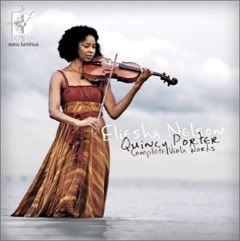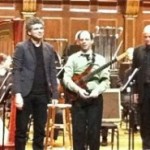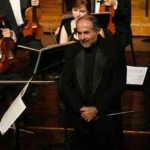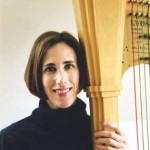
GRAMMY®-nominated violist Eliesha Nelson has a lot going on these days. In addition to playing viola in the Cleveland Orchestra, she has embarked on a project of finding and recording worthy yet neglected works for her worthy yet often neglected instrument. Her first recording features the music of Quincy Porter, an American composer I hadn’t heard of before, but who I’m glad to know about after listening to her CD, Quincy Porter: Complete Viola Works
. (You can hear excerpts from the recording on her website.) She spoke with me recently about her discovery of the viola and subsequent advocacy for it, the state of the arts today, and her own homegrown experiments in music education!
MMN: Your debut recording is nominated for four GRAMMYS. Congratulations! What was your reaction when you found out about it?
EN: Shock! Doing the recording was a labor of love, since I’m not exactly a household name (Editor’s note: not yet!). Trying to raise money and do all the organization of the CD – because the music is varied: orchestra, chamber music, and all of that – I’d never done it before, so I learned an awful lot. But I’m just really thrilled; everything has worked out much better than I ever could have hoped.
MMN: You’ve appeared on other recordings as an orchestra member, but you wrote that recording a solo album was “the most thrilling, intense, and eye-opening musical experience I’ve had in years.”
EN: The thing I really love about the recording session is, it’s almost like getting a lesson from a master teacher, because when you listen back to something really well-recorded, you can hear so much more. There’s just so much to learn about how I truly want to phrase things, how I really want to express something. It’s an exciting experience.
MMN: You grew up in North Pole, Alaska. How did your family come to live there, and what was it like?
EN: There’s an air force base nearby, and my father was stationed there. It’s a great place to grow up. The beauty of Alaska itself is really inspiring. I think that can really go a long way, if you’re surrounded by natural beauty, or great architecture, or anything like that. It really helps to lift the soul and feed the spirit.
MMN: How did you become interested in music?
EN: Both of my parents had a little bit of musical training, my mom more than my father. It was a tradition on her side of the family that everyone had to learn an instrument. My mother’s mother played violin and piano, so my mother and her sister had to learn violin and piano, therefore I and my sister learned violin and piano. That’s how it all started.
MMN: Then you went off to the big city when you were only 16, to attend the Young Artists Program at the Cleveland Institute of Music. What was that like for you?
EN: Yeah, I went to Cleveland, which is not so big a city, but for a kid coming from Alaska, it was huge, and quite a culture shock. It was really difficult. My personality was more introverted back then. I was happy to be reading the encyclopedia in my room, so it was really shocking all of a sudden to be in a city where there were so many more people, living on my own in the college dorms. I don’t think the CIM does that for their young artist program anymore – the kids have to live with a family. But I went to a private girls’ school, which expected a lot academically. I had so much work, I was too busy to even think of misbehaving!
MMN: But then after many years of training as a violinist, you were seduced by this other instrument, the viola!
EN: Yeah, accidentally – it was a great accident! I had come back from a Fulbright grant, and I was just sort of wobbling around, not really sure what I was going to do with violin. and found myself dabbling a little bit with viola. That summer, I was a teaching assistant for my former teacher at Oxford School for Strings. Because they always need violists for their quartets, I said, “Oh, yeah, I’ve been dabbling with viola. I can’t read the clef, so put me in the kiddie groups.”
But I ended up playing the Shostakovich eighth quartet, and the Barber quartet, which has a really huge viola part. I had to write the names of the notes above practically every note, but I made it through. It was suggested that I play for Bob Vernon, the principal violist of the Cleveland Orchestra, and he said, “Come study with me.”
I really came to love the sound and the possibility of the instrument. There are so many phenomenal violists now, that the expectations of what can be done and how good a violist is or should be have really skyrocketed.
MMN: To go from performing the Brahms violin concerto to writing note names in your part must have been an interesting shift!
EN: Yeah, it was! But when I was dabbling with viola, I still wasn’t really thinking, “Oh, I should do this.” It was just sort of, “Isn’t this fun?” And then I really started studying viola, and I said, “You know, there’s really something to this!”
MMN: While planning your debut recording, you read through many neglected viola works. What attracted you to the music of Quincy Porter particularly?
EN: For my first CD, I wanted to do works of one composer, and I wanted that composer to be an American. To find enough music for one CD by an American composer, 72 minutes worth of music for the viola, was actually hard. I sort of finagled it with Porter, adding the violin and viola duo, and the harp and viola duo. Even though those are real chamber music pieces, the viola is prominent enough that it works.
MMN: Porter was a violist himself. Does that come through in how he writes for the instrument?
EN: Yes, it does. His music falls very nicely in the hand. It can be really challenging, of course, with a lot of technical bits. He played violin as well, but I think he preferred to perform on viola.
Another thing I really like about him is, he was a big lover of Renaissance music, as am I, so a lot of his melodies are these very long lines that just keep going. I think that also lends itself very well to the viola; it really creates a nice sustained melody.
MMN: I love the viola; it’s one of my favorite instruments to write for. And several of the works on your CD feature the kind of elegiac, slow, sustained lines you expect from the viola – which I love! But you also have dazzling technical passages, like in the Speed Etude. I’m not used to hearing that kind of Paganini-esque technique done on the viola, and I can’t think of another piece originally written for viola that goes for it the way that piece does!
EN: I think he’s just approaching it as a solo instrument. If you think of it that way, the sky’s the limit as to what you can express. I think the tendency has been, “Oh, it’s a viola.” Everyone thinks of viola jokes – the bad second violinist who’s so bad that they have to play viola. But like I said, I think that mentality is really changing, because there are lots of really fantastic violinists who are choosing viola, and being very successful at it, and not accepting that attitude.
MMN: I have to admit, I have a fondness for viola jokes, even though I love the instrument. Do you have any favorites?
EN: Being that I play in an orchestra, one of my favorites is, you see a violist and a conductor crossing the street – which one do you shoot first? The conductor – business before pleasure.
MMN: Right!
EN: There’s another piece that I recorded fairly recently by Alexander Winkler, from a set of two small pieces: one of them is called The Spinning Top, and the other is called Elegy. The Spinning Top is not quite as fast as Speed Etude, but it has that same kind of perpetual motion idea, that same kind of showmanship.
I’m finding all this repertoire for the viola that is out of print and neglected, just not played. And I’m listening to it thinking, “Why would you want to play violin and cello transcriptions when this music exists, and it’s really good? Why? Why isn’t this stuff played?” That’s something that I’m really starting to advocate for. Everyone’s too busy playing the Franck violin sonata on viola, or whatever.
In a way, I’m happy that I didn’t start off earlier as a violist, playing all the repertoire I learned on violin, because I feel like I’ve played it on violin – I don’t want to play it on viola! And I’m seeing all this other repertoire that interests me so much more.
MMN: Are there other, less well-known composers that you would say more violists should investigate?
EN: Oh, absolutely. My next CD is of Russian composers: Alexander Winkler, who I just mentioned; Varvara Gaigerova, a woman who didn’t live very long, about 42 or 45 years; Sergei Vasilenko, who’s a bit better-known, but still not really played much, at least in this country; and Paul Juon, who wrote a really fantastic viola sonata.
And of course, there are many more American composers. Being an American, I think it would be nice if Americans played more American music, not just the so-called standards.
MMN: Have you commissioned any new works?
EN: I haven’t. I always assumed that that took a lot of money, and I haven’t really looked into that much yet. But that’s something I would definitely love to do.
MMN: Well, many of us composers will write for food, or even less – you just have to ask!
EN: That’s true!
MMN: You won an audition for the Detroit Symphony around the same time that you won the audition for the Cleveland Symphony, and you ended up in Cleveland. Did your Cleveland background make that an easy choice?
EN: Well, it helped that Cleveland is Big Five. And it’s so unfortunate, what’s going on right now in Detroit, with their strike. It’s like a national treasure is being trashed. It’s like the looting of a museum – that’s what it feels like to me. To create an orchestra of that caliber takes a lot of money, a lot of love, and a lot of support. And to think that it’s okay to dismantle it or to just let it go… If Detroit lets this happen, it’s not gonna come back. It’s very sad to me.
MMN: I’m especially sad about it, because I used to live a few blocks from the Max Fisher Center in Detroit, and I would walk down there and go to the symphony all the time.
EN: Culture is so important. Yes, we need to learn to read and write, but without culture, we’re not human; we can’t have the catharsis we need, the inspiration we need. I find it incredibly upsetting.
MMN: I do, too. The state of the arts in this country today, is very mixed, I think. There are wonderful things going on all over the place, and at the same time, so many organizations are having problems. It just seems like we’re in the best of times and the worst of times simultaneously. What do you think about the state of the arts, and how it’s going to work going forward?
EN: Very good question. You have so many people who think, “Why do we need to fund the arts? Why do we need this?”
MMN: I think everybody thinks that somebody else is going to support it – some imaginary person.
EN: Exactly. I’m just keeping my fingers crossed. The Cleveland Orchestra went on a twenty-four hour strike during our last negotiations. Luckily, it didn’t go any further than that. It was the first strike in, I think thirty years.
MMN: What else can you tell me about the classical music scene in Cleveland?
EN: It’s a good scene. There’s a really good core of support. Again, like you mentioned, we’ve had some really vital organizations that have gone by the wayside – very good organizations that employed the local freelancers. So right now the freelancers are really having a tough time. But then there’s an organization called CityMusic, which is starting to thrive and do really well. They offer free concerts to the public, but the musicians are still paid, There is grant support and private funding for that.
MMN: What about music education?
EN: That is something the orchestra is really starting to take seriously. Music in the schools is, of course, one of the very first things to get cut. When they say, “Oh, the students need to do better on tests,” they cut physical education, they cut art, they cut music. It’s really too bad. There’ve been countless studies that show the importance of music, the importance of the arts in general, how it impacts learning, and how it can be used to help with learning other subjects.
MMN: Absolutely. I think I read in your biography that you’re involved in teaching, too?
EN: I was, before I had a baby. My husband is a mathematical biologist, and he’s employed at the University of Arizona in Tuscon, so we’re commuting. I just can’t do it right now – there’s only so many hours in the day!
MMN: I saw a video on your website where you were playing while you were pregnant. Did it feel different to play during that time?
EN: Well, physically it was more tricky. I was always tired, so physically it was much more demanding. When Dorian Sono Luminus asked me to do the video, I said, “I’ll be six months pregnant at the time you’d like me to do this video, and I’m not sure if that’s really what you would want.” They didn’t even think about it – they said, “That’s okay.”
MMN: I actually think it’s great for the child. My mother was learning to play the piano when she was pg with me, and I like to think it made an impact. And as your child grows, seeing you play music, it’s great.
EN: Yeah, he’s surrounded by it – he has no choice! It’s also interesting; I use sign language with him, and of course lots of clapping games and stuff like that. But there are certain things that I sing to him, certain commands. Or at a certain time of day when we’re going to do something, I’ll sing to him. And he knows what that means. If I see him wandering off, and I tell him to come back, he might look at me or he might not; he might keep going. But if I sing to him the little “Come Back” song, he almost always does it immediately. I find that really fascinating.
MMN: It is! You have your own individual study for the effectiveness of music education, right in your home – you should write a scholarly paper about that! How does he respond when you play the viola around him?
EN: Well, the viola is kind of like the older child who’s being played with, and not him. It’s like, why aren’t you playing with me? What are you doing with that viola?
MMN: I wanted to ask you kind of a frivolous question, if you don’t mind. The cover photo on your CD is very beautiful; it shows you standing in water while playing your viola. Where was that taken?
EN: That was taken in Lake Erie, at Edgewater Park in Cleveland. I have a friend who’s a filmmaker – his name is Matthew Gregor. When I was in the middle of recording, he said, “What are you doing for the cover?” and I looked at him and said, “I’m too busy trying to figure out x, y and z!” and he said, “Oh, well, I have a good photographer and makeup artist. I’ll help you out with the cover.” He said, “I have this idea, this image of you in the water. I think that would be very nice.” And I said, “Okay.” And so that’s why I’m in the water, with my viola!
MMN: You must have been cold!
EN: It was freezing! It was early October, and it was at dawn.
MMN: And you’re in that thin, spaghetti-strap dress!
EN: Yeah, I was freezing. I didn’t spend a lot of time in the water. And we had blankets and towels and everything like that, so immediately afterwards, we got in the car and got wrapped up and dried off.
MMN: It’s a gorgeous dress. Who designed it?
EN: Her name is Inda Blatch-Geib. She made the dress, and also did the hair and makeup. The photographer was Derryl Strong.
MMN: What would you say to a young person who was interested in viola, interested in going into music? Any advice?
EN: Outside of the typical practice, practice and more practice? Make lots of friends, and make them good friends, because the people you meet in college and in music camps will most likely be the people you work with if you continue in the field. And it’s good to have people that want to work with you, because really, that seems to be what it’s about.
MMN: On that topic, your colleague John McLaughlin Williams plays several different roles on your recording, and is a very accomplished musician (and a GRAMMY winner as well!).
EN: Oh, yeah, incredibly.
MMN: Did you meet him in Cleveland?
EN: I did. I met him at the Cleveland Institute of Music, when I was a violinist. He’s just incredible; I think he’s really close to being a musical genius. He’s never had a piano lesson in his life, and he plays really well. And he’s a great conductor. He was the one who kept nudging me to do a recording. When I joined the Cleveland orchestra, he said, “You’ve got a great job – do a recording.” And I said, “Aaah! I’ve been playing viola for three years – I still can’t read the clef!”
MMN: You mentioned that your next recording is going to be Russian composers. Have you started recording it yet?
EN: Yeah, actually, I finished that. Next, I’m hoping to do something with Jeffrey Mumford, a really wonderful composer. He has a fair amount of viola music, so we could have a CD that’s not exactly the same as the Porter, but the same kind of thing, with chamber works plus a concerto, plus a sonata.
MMN: You’ve got a full plate! I appreciate you taking the time to talk to me; it’s been really fun and interesting.
EN: Thanks for your interest!
Miss Music Nerd Recommends:
Quincy Porter: Complete Viola Works






